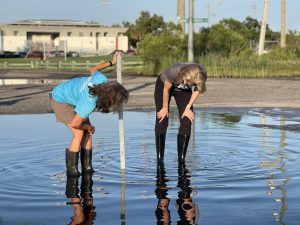South Carolina Aquarium and Southern Environmental Law Center track high tides throughout Charleston
August 15, 2023New Partnership Will Bolster Resilience Efforts Statewide
Two weeks ago, the South Carolina Aquarium and the Southern Environmental Law Center (SELC) kicked off their recently formed partnership and quickly found themselves in deep water — quite literally — in downtown Charleston.
They were in pursuit to photograph tidal flooding on Hagood Avenue and record their findings. As they waded through 7 inches of water, questions began to surface. If this flooding is occurring a few days prior to a predicted king tide, how debilitating will these rising waters be during some of the king tide events happening later this year or in future years?
Click on images below for a better look.
Sea level is rising faster in our region than national and global averages. On the east coast of the United States, the average tidal range between high and low tide is about 5.5 feet. When the moon is in its closest position to earth, a strong gravitational pull can result in tides reaching 6.5 feet or more, unofficially known as king tides. These levels rival storm surges caused by hurricanes but can occur with or without extreme weather events. King tides can result in disrupted commutes, flooded streets, dangerous runoff in our roads and waterways and significant habitat degradation.
In the Lowcountry, 20 king tides were predicted in 2023… yet that evening’s high tide wasn’t initially on the list. Predictions estimated the tide would reach 6.3 feet (a level higher than a routine tide), yet preliminary data from the National Oceanic and Atmospheric Administration measured the tide at 6.56 feet. Roads, drainage systems, and landscaping features can cause significant changes in how neighborhoods experience tidal events. That’s why having local data on flood risks is so critical for helping officials plan for and prevent flood impacts.
In 2017, the Aquarium founded the Resilience Initiative for Community Engagement (RICE) to focus on fieldwork opportunities that help alleviate impacts of climate change. This initiative connects at-risk communities across the state with the tools to understand and track trends in flooding and habitat loss, ultimately leading to actionable change. Such tools include the SeaRise Project, located in the South Carolina Aquarium Citizen Science app.
“Local residents are coping with the impacts of sea level rise more and more frequently and it’s easy to become overwhelmed by the problem,” said South Carolina Aquarium director of conservation Dr. Sara McDonald. “The SeaRise Project empowers residents to be part of the solution by collecting data that can directly support local flood modeling and resilience planning.”
As the Aquarium’s efforts in resilience grew, so did their support from community members and partners. SELC recently joined forces with the South Carolina Aquarium to become the lead partner of RICE. This partnership will support ongoing resilience work, from habitat restoration projects and citizen science data collection to training workshops and community outreach events to help tackle some of the toughest environmental challenges facing South Carolina.
“As South Carolinians experience rising seas and worsening weather events, community partners are the first line of defense. They can ground truth trends and prioritize where intervention is needed most,” said Alys Campaigne, SELC’s Climate Initiative Leader. “At SELC, we are dedicated to finding solutions to solve the climate emergency that respond to local needs. That’s why we are so proud to partner with the South Carolina Aquarium on their critical, science-focused resilience work.”
Together, the Aquarium and SELC are committed to galvanizing community involvement in their resilience work and are asking for help in collecting data during upcoming predicted king tide events from August 29–September 1. Citizen scientists are encouraged to measure and photograph flooding that occurs in their own area or visit one of the five Charleston locations marked by official SeaRise signs with rulers to measure water levels. All data can be submitted to the SeaRise Project located in the South Carolina Aquarium Citizen Science app, available in the App Store or on Google Play.
For more information, visit scaquarium.org/resilience
About the South Carolina Aquarium
The South Carolina Aquarium, Charleston’s No.1 family attraction, is home to more than 5,000 animals, from river otters and sharks to sea turtles and shorebirds, and represents the rich biodiversity of our state — from the mountains to the sea. Visitors can also get an inside look at the Sea Turtle Care Center™, a working hospital dedicated to the rescue, rehabilitation and release of sick and injured sea turtles. While fulfilling its mission to promote education, conservation, and an exceptional visitor experience, the Aquarium also presents sweeping views of the Charleston Harbor along with interactive exhibits and programs for visitors of all ages.
The South Carolina Aquarium is a 501(c)(3) nonprofit organization. The Aquarium is open daily from 9 a.m.–5 p.m., with the last entry at 3:30 p.m. The Aquarium is open seven days a week with the exception of Thanksgiving Day, December 25 and a half day on December 24 (open 9 a.m.–noon). Annual Aquarium membership with unlimited visits starts at $99. For more information, call (843) 577-FISH (3474) or visit scaquarium.org.
About the Southern Environmental Law Center
The Southern Environmental Law Center is one of the nation’s most powerful defenders of the environment, rooted in the South. With a long track record, SELC takes on the toughest environmental challenges in court, in government, and in our communities to protect our region’s air, water, climate, wildlife, lands, and people. Nonprofit and nonpartisan, the organization has a staff of 200, including more than 100 attorneys, and is headquartered in Charlottesville, Va., with offices in Asheville, Atlanta, Birmingham, Chapel Hill, Charleston, Nashville, Richmond, and Washington, D.C. For more information visit southernenvironment.org



















